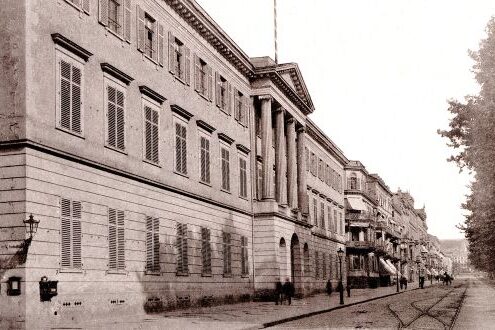Association for Nassau Antiquity and Historical Research e.V.
In 2012, the Verein für Nassauische Altertumskunde und Geschichtsforschung celebrated its 200th anniversary. Its initiators in 1812 included the pastor Johann Christian Reinhard Luja and the court chamber councillor Christian Friedrich Habel.
The association arose from the desire to create a forum for the study of Roman and German antiquities in the Duchy of Nassau, which was established in 1806 as a Napoleonic vassal state. At the same time, the new state was to be given a historical basis of legitimacy. The initiators included the Wiesbaden-born pastor Johann Christian Reinhard Luja and the court chamber councillor Christian Friedrich Habel from Wiesbaden-Schierstein. Together with the Frankfurt scholar and art collector Johann Isaak von Gerning, Habel drew up a draft for the association's statutes. They were entitled "Basic Laws of the Antiquities Society for the Duchy of Nassau", were dated November 2, 1812 and can be considered the founding document of the society. They received the sovereign's approval in April of the following year.
However, the defeat of Napoleon, further border shifts and the rebuilding of Nassau as a state within the German Confederation led to a lengthy interruption, meaning that the founding process was not completed until nine years later. The statutes were revised once again and approved by the Duke in the amended form on August 30, 1820. The formal constitution took place on December 5, 1821.
Initially, the association's activities focused primarily on archaeological excavations and the preservation of objects of cultural and historical value. The finds were brought together in the former Erbprinzenpalais on Wilhelmstraße and formed the basis of the Nassau Antiquities Collection. In the 1840s, the evaluation of archival sources became increasingly important, so that from then on, the study of medieval and modern regional history became more and more important. The association began publishing the Nassau Annals in 1827.
The second half of the 19th century is characterized by increasing organizational differentiation. In 1851, sections for the study of Roman antiquities, for the study of seals and for medieval monuments were established. In 1861, a section for regional history was added. At the same time, the museum became increasingly detached from the self-administration of the association. In 1858, the management of the museum was transferred to a state-paid curator. In 1897, the Historical Commission for Nassau, which is still active today, was constituted following the formation of the earlier section. Shortly after the turn of the century, the association also lost its direct responsibility for the preservation of historical monuments, which in 1902 became the responsibility of the municipal association of the Wiesbaden administrative district. In terms of personnel, the period was mainly characterized by the grammar school professor Johann Heinrich Karl Rossel and the curator Karl August von Cohausen. At times, prominent politicians such as the leader of the Nassau Liberals Karl Joseph Wilhelm Braun (1861-67) and the revolutionary minister Jakob Ludwig Philipp August Franz Hergenhahn (1872-1874) acted as directors of the association.
After the reduction of its semi-governmental functions, the association increasingly turned its attention to the general public in the 20th century. Picking up on a general trend of the time, it now gave priority to the cultivation of the idea of local history. In addition to the Nassauische Annalen, the Nassauische Heimatblätter were published as a popular counterpart. The increasing interest in folklore and the founding of local groups point in the same direction. However, regional historical research remained a central field of activity. The newly drafted statutes of 1921 expressly declared the support of scientific research into the past as a purpose of the association. The association had been organizing lectures since the 1850s and had increasingly been organizing excursions since the 1880s. Now, for the first time, these activities are also mentioned in systematic form as a means of the association's practical work.
The association strictly avoided taking political sides. After the National Socialists came to power, some formal concessions could not be avoided. For example, the statutes had to be amended to include the passage that the association conducted its research "on a national basis". At least four members of the NSDAP or related organizations now had to be on the board. However, both the lectures and the publications could be held free of National Socialist propaganda.
The association therefore had no difficulty in continuing its activities beyond the collapse of 1945. As early as November 1945, museum director Ferdinand Kutsch, who had succeeded Privy Archivist Paul Wagner as chairman since 1932, convened the first board meeting. On June 8, 1946, the association obtained the necessary license from the military government for its public activities. The division of the association's territory into two occupation zones and then the states of Hesse and Rhineland-Palatinate caused problems. However, this was also a particular source of motivation. As the custodian of regional historical research in the former Nassau areas, the association endeavors to maintain its work across borders. To this day, there are branch associations on both the Hessian and Rhineland-Palatinate sides.
On May 20, 2012, the association celebrated its 200th anniversary with a ceremony in the Christian Zais Hall of the Wiesbaden Kurhaus. The main association currently has 950 members, the branch associations around 500. The 124th volume of the Nassauische Annalen will be published in 2013.
Literature
- Struck, Wolf-Heino
Foundation and development of the Verein für Nassauische Altertumskunde und Geschichtsforschung. In: Nassauische Annalen 84, Verein für Nassauische Altertumskunde und Geschichtsforschung (ed.), Wiesbaden 1973 (pp. 98-144).
- Verein für Nassauische Altertumskunde und Geschichtsforschung (Hrsg.)
Commemorative publication on the occasion of the 175th anniversary of the Verein für Nassauische Altertumskunde und Geschichtsforschung 1812-1987, Wiesbaden 1987.
- Schüler, Winfried
Preserve - Experience - Understand. 200 years of the Association for Nassau Antiquity and Historical Research. Verein für Nassauische Altertumskunde und Geschichtsforschung (ed.), Wiesbaden 2012.
